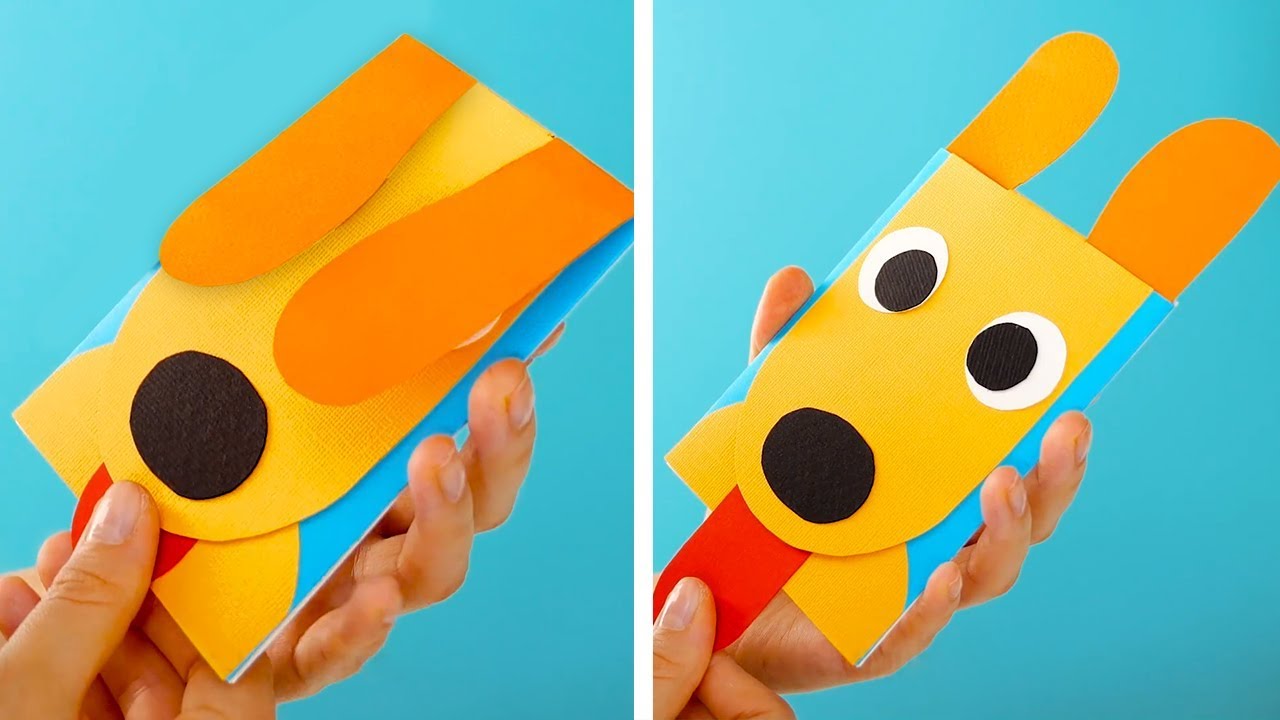Things to make out of paper – a simple, readily available material that holds endless creative possibilities. From childhood crafts to intricate art, paper has been a source of inspiration and entertainment for centuries. Whether you’re a seasoned crafter or a curious beginner, the world of paper crafts offers something for everyone.
This guide explores the diverse ways paper can be used, delving into various crafts, decorations, art forms, and even its role in history, science, and the future. Get ready to unleash your creativity and discover the amazing things you can make with just a sheet of paper.
Paper for Organization and Storage

Paper, beyond its traditional role in writing and printing, offers a surprisingly versatile medium for organization and storage. From simple file folders to intricate origami creations, paper can be transformed into practical and stylish tools to manage your belongings and keep your life organized. This section explores various ways to utilize paper for organizational purposes, covering DIY organizers, envelopes, greeting cards, and more.
DIY Paper Organizers
Paper can be easily manipulated to create a variety of organizers, making it a cost-effective and creative option for organizing your belongings. Here are some ideas for DIY paper organizers:
- File Folders: Simple file folders are essential for keeping documents organized. You can create your own using sturdy cardstock or even repurposed cardboard. Cut the paper to the desired size, fold it in half, and secure the edges with glue or tape. Decorate them with patterns, labels, or even fabric for a personalized touch.
- Magazine Holders: Keep your magazines tidy and accessible with DIY magazine holders. Use thick paper or cardboard to construct a rectangular box with open ends. Decorate the exterior with paint, fabric, or wallpaper for a visually appealing design.
- Gift Boxes: Paper can be used to create elegant and personalized gift boxes. There are numerous online tutorials that guide you through various folding techniques to create boxes of different sizes and shapes. You can add decorative elements like ribbons, bows, or embellishments to enhance the presentation.
Making Envelopes and Greeting Cards
Paper is the fundamental material for creating envelopes and greeting cards. By mastering basic folding techniques, you can craft personalized and unique envelopes and greeting cards for various occasions.
- Envelope Folding Techniques: The most common envelope folding technique involves creating a rectangular flap that is folded over to seal the envelope. This technique can be modified to create different styles, such as square envelopes or envelopes with triangular flaps.
- Greeting Card Folding Techniques: Greeting cards typically involve folding a piece of paper in half to create a card with a front and back. You can experiment with different folds to create unique shapes, such as a tri-fold card or a pop-up card.
Paper-Based Organizational Tools
Paper can be used to create a wide range of organizational tools, each with its own unique function and benefits. Here is a table summarizing some common paper-based organizational tools, their functions, materials required, and their benefits:
| Tool | Function | Materials | Benefits |
|---|---|---|---|
| File Folders | Organize and store documents | Cardstock, cardboard, glue, tape | Cost-effective, customizable, easy to create |
| Magazine Holders | Organize and display magazines | Thick paper, cardboard, paint, fabric, wallpaper | Keeps magazines tidy and accessible, adds visual appeal |
| Gift Boxes | Present gifts in a stylish and personalized manner | Paper, glue, ribbon, bows, embellishments | Adds a personal touch to gifts, offers creative freedom |
| Envelopes | Securely store and transport letters, documents, and small items | Paper, glue, tape | Versatile, customizable, can be decorated for special occasions |
| Greeting Cards | Express personal messages and sentiments | Paper, glue, embellishments | Personalized, creative, can be tailored to different occasions |
| Notebooks | Record notes, ideas, and thoughts | Paper, binding materials (e.g., staples, stitches) | Portable, customizable, encourages creativity |
| To-Do Lists | Organize tasks and prioritize activities | Paper, pen, sticky notes | Visual reminder of tasks, promotes organization and productivity |
Paper in Fashion and Design: Things To Make Out Of Paper

Paper, a seemingly humble material, has a remarkable history in fashion and design. Beyond its traditional use for writing and printing, paper has been creatively employed to create stunning garments, accessories, and even architectural structures. This section explores the multifaceted ways in which paper has transcended its conventional boundaries to become a source of inspiration and innovation in the world of fashion and design.
Paper in Fashion, Things to make out of paper
Paper has long been a source of inspiration for fashion designers. The lightweight, versatile nature of paper allows for experimentation with intricate designs and unique textures.
Paper dresses gained popularity in the 1960s, particularly as a response to the growing demand for affordable and disposable fashion. Designers like Scott Paper Company and “Paper” by “Paper” (a company that specializes in paper clothing) embraced the concept of paper as a wearable material. These dresses, often made from tissue paper or lightweight cardboard, were designed to be worn for a single occasion and then discarded.
Beyond dresses, paper has been used to create a wide range of fashion accessories, including jewelry, hats, shoes, and bags. Paper jewelry, for instance, can be made by folding, cutting, and layering paper to create intricate designs.
- Paper jewelry often utilizes techniques like origami, kirigami, and quilling to create intricate designs.
- Paper hats can be crafted from various types of paper, including corrugated cardboard, craft paper, and even newspaper.
- Paper shoes have gained popularity as a sustainable and eco-friendly alternative to traditional footwear.
- Paper bags have become a stylish and practical accessory, particularly in the realm of eco-conscious fashion.
Paper Architecture
The use of paper in architecture has a rich history, dating back to ancient times. Paper, in its various forms, has been utilized to create temporary structures, elaborate models, and even full-scale buildings.
- Paper models have long been used by architects to visualize and experiment with designs.
- Paper lanterns, prevalent in many cultures, demonstrate the structural integrity and aesthetic appeal of paper.
- Papercrete, a mixture of paper fibers and cement, has gained popularity as a sustainable building material.
- Folding techniques, such as origami and kirigami, have been employed to create complex and intricate paper structures.
Applications of Paper in Fashion and Design
The following table showcases various applications of paper in fashion and design, highlighting the materials used, techniques employed, and the aesthetic appeal of each example:
| Application | Materials | Techniques | Aesthetic Appeal |
|---|---|---|---|
| Paper Dresses | Tissue paper, cardboard, coated paper | Cutting, folding, layering | Lightweight, whimsical, often featuring bold colors and prints |
| Paper Jewelry | Cardstock, origami paper, decorative paper | Origami, kirigami, quilling | Intricate designs, delicate textures, vibrant colors |
| Paper Hats | Corrugated cardboard, craft paper, newspaper | Folding, shaping, embellishing | Unique shapes, textures, and patterns |
| Paper Architecture | Cardboard, papercrete, origami paper | Folding, layering, construction | Geometric shapes, intricate designs, sustainable materials |
Paper in History and Culture
Paper, a seemingly simple material, has played a pivotal role in shaping human history and culture. Its invention revolutionized communication, knowledge dissemination, and artistic expression, leaving an indelible mark on civilizations across the globe.
The Origins of Paper
Paper’s origins can be traced back to ancient China, where it was invented during the Han Dynasty (206 BCE – 220 CE). The invention is attributed to Cai Lun, a court official who developed a method for making paper from fibers of the mulberry tree, hemp, rags, and fishing nets. This groundbreaking innovation allowed for the creation of a durable, lightweight, and affordable writing surface that could be easily produced and transported.
Paper’s Impact on Communication and Knowledge Dissemination
The invention of paper revolutionized communication and knowledge dissemination. Before paper, writing was typically done on materials like bamboo strips, silk, and clay tablets, which were cumbersome and expensive. Paper, on the other hand, was relatively inexpensive, portable, and versatile, making it ideal for writing, printing, and recording information.
- Paper facilitated the spread of knowledge and ideas, contributing to the growth of education, literature, and scientific advancements.
- The printing press, invented in the 15th century, utilized paper to mass-produce books, making information more accessible to a wider audience.
- The development of paper played a significant role in the rise of literacy and the emergence of a more informed public.
Paper’s Cultural Significance
Paper has held cultural significance in various societies throughout history. It has been used in religious practices, artistic expressions, and everyday life.
- In many cultures, paper is used in religious ceremonies and rituals. For example, in Japan, paper lanterns are used during festivals, and origami, the art of paper folding, is often used in religious ceremonies.
- Paper has also been a fundamental medium for artistic expression. Calligraphy, the art of beautiful handwriting, has been practiced on paper for centuries in China, Japan, and Korea. Paper is also used in painting, drawing, and printmaking.
- Paper plays a crucial role in everyday life, from writing and reading to packaging and hygiene. It is used in countless ways, reflecting its versatility and importance in modern society.
Historical Artifacts and Cultural Practices
Numerous historical artifacts and cultural practices demonstrate the enduring importance of paper throughout history.
- The Dead Sea Scrolls, a collection of ancient Hebrew manuscripts discovered in the late 1940s, are written on parchment, a type of animal skin that was used as a writing surface before paper became widely available.
- The Gutenberg Bible, printed in the 15th century, is a landmark example of the impact of the printing press on knowledge dissemination. It is considered one of the most important books ever printed.
- The art of calligraphy has been practiced for centuries in many cultures, with examples ranging from ancient Chinese scrolls to modern Japanese calligraphy.
Epilogue

The world of paper is vast and ever-evolving. From traditional origami to cutting-edge paper technology, the possibilities are endless. As you explore the creative potential of paper, remember that the most important ingredient is your imagination. So, grab a sheet of paper, let your creativity flow, and enjoy the journey of crafting with paper.
Paper is incredibly versatile! You can fold it into origami, create intricate paper flowers, or even build a miniature world with papercraft. If you’re looking for a fun outdoor activity, you can also use paper to design and decorate a mud kitchen, like the ones featured on this website.
After all, even the most imaginative mud kitchen needs some paper details, like menus, recipe cards, or even a little paper money for pretend play!




